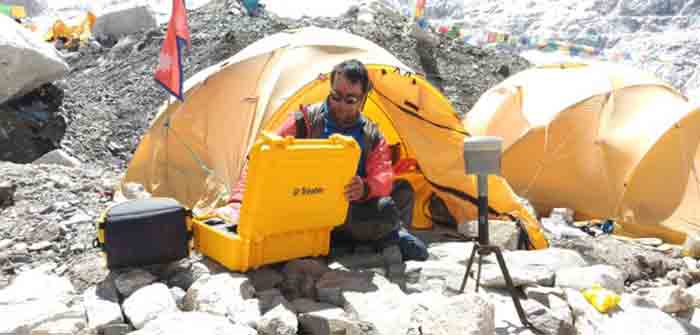
Born in Hadaule Village of Kaski District, Khim Lal Gautam was raised in the shadows of stunning mountains. From his courtyard, he could see Mount Dhaulagiri and Mount Annapurna most days of the year.
But never had it occurred to him in his wildest dreams that would one day climb mountains. And never had he imagined that he would one day scale the world’s highest peak, Mount Everest, to measure it. Even when he made his first summit of Everest, in 2011, he had never thought he would be the one to lead the national Everest measuring survey team and capture the data that would be used to determine the precise height of the world’s tallest mountain.
“I studied in Pokhara. Initially, mountaineering wasn’t something that I thought I’d be involved in. This all happened as a matter of coincidence,” says Gautam, an engineer, who looks strong and has a tall physique.
Gautam has not only summited Everest twice but is also the world’s first surveyor to reach the top of the mountain to measure, with the aid of state of the art technology, the actual altitude of the peak. In doing so, he has helped Nepal come up with the definitive height of Everest.
In May last year, Gautam, 36, leading a national team of surveyors, with heavy loads of equipment, reached the top of Everest and took the measurement, before climbing down to give Nepal’s survey department 1 hour 16 minutes of satellite data that he had collected from the summit. It took almost a year for the department to process and analyse the data to confirm the height.
After having risked life and limb on the dangerous slopes of the mountain, it was only natural that Gautam and his team of surveyors wanted Nepal to solely declare the height of Everest. But the surveyors, who were successful in preventing India from getting involved in the task of remeasuring Everest, couldn’t stop influential China.
Despite protests from Nepali bureaucrats, China–which has been doling out millions of dollars as financial assistance to Nepal, to bolster its influence in recent years in Nepal–easily persuaded Nepal’s ruling leaders to turn the ongoing Everest measurement process into a joint project.
In October 2019, during Chinese president Xi Jinping’s visit to Nepal, Nepal and China had agreed to jointly announce Everest’s new height. After the agreement, China sent a team of surveyors from Everest’s northern side and remeasured Everest using the Yellow Sea as the baseline. On Tuesday, during a programme organised in Kathmandu to officially declare the new height of Everest, the consensus height was announced jointly as per the agreement reached between the two countries.
Over many months leading up to Gautam’s summit of Everest, other Nepali surveyor scientists had completed the tedious step-by-step ground-leveling survey from Maadar of Siraha, a Nepal-India-border point, and connected the sea-level baseline coordinates of the Bay of Bengal, India, to Everest Base Camp, the nearest measurable point on the mountain. From there, the surveyors determined the reference points that were to be used in conjunction with the satellite data obtained by a GPS receiver and antenna that Gautam was to place atop Everest during his summit later.
Meaning, the final calculation could only be made once Gautam had climbed to the top of Everest and placed the GPS equipment there. While he and his team made their ascent, his seniors at the Survey Headquarters, Kathmandu, spent a sleepless night observing their progress, and they held their breath, especially as he headed up for the summit push from camp IV to complete the most difficult phase of the Nepali mission.
“We all were keenly observing all these activities from Kathmandu, especially on the summit-push day. We celebrated after the team stood atop Everest and captured the data because we had achieved the first part of our mission,” said Susheel Dangol, the coordinator of Nepal’s Everest measurement project. “Today, we marked the success of the final part of our overall mission.”
Gautam’s mountain adventure was not an easy one.
Gautam had first read about Mount Everest, in his textbook, when he was in grade four. But rather than Mount Everest, he was more fascinated by the mountains he could see from his village. Later, he did dream of climbing mountains, but he couldn’t pursue that aim because he was focused on his engineering degree; after he completed it, he joined government service and was busy with the work there.
In the course of his government service, he came to learn that bureaucrats like him were preparing to climb Mount Everest under the banner of ‘Nepal Civil Servants’ Everest Expedition 2011’. Nepal was marking 2011 as a Visit Nepal Year to attract more tourists to the country, and a group of civil servants, led by the then secretary Leela Mani Paudyal, was preparing to scale Mount Everest. The aim of the expedition was to promote Nepal’s mountain tourism, in the country and beyond. Nepal Mountain Academy, the government organisation that was authorised to select 20 bureaucrats who were physically and technically fit to ascend Everest, summoned prospective candidates to Kakani to test their climbing skills.
Gautam was one among many contestants. At the end of the trials, his name was shortlisted as an alternative candidate. Later, when the group were taken to climb Yala Peak, in Langtang region, as part of the rehearsal for the Everest summit, Gautam, who was initially ranked 21st, was named the best performer. After scaling Yala, he climbed yet another mountain, Island Peak, in the Khumbu region, before climbing Everest.
Of the total of 15 climbers selected for the expedition, 11 successfully stood atop Everest. The survey engineer, then 27, was the youngest climber of his team…
Continue Reading